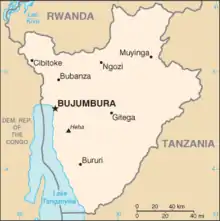November 1966 Burundian coup d'état
On 26 November 1966, Michel Micombero, Burundi's 26-year-old Prime Minister, ousted the 19-year-old king (mwami) of Burundi, Ntare V, in a coup d'état. Ntare was out of the country at the time and the coup leaders quickly succeeded in taking control. Micombero declared an end to the monarchy and the Kingdom of Burundi became a republic with Micombero as its first President.[1][2]
 | |
| Date | 26 November 1966 |
|---|---|
| Location | Bujumbura, Kingdom of Burundi |
| Type | Military coup |
| Motive | Regime change |
| Target | Royal Palace, Bujumbura |
| Organised by | Michel Micombero |
| Outcome | Coup succeeds
|
| History of Burundi |
|---|
Background
The November coup of 1966 was the last of three coups to take place in Burundi during 1965 and 1966. The previous coups (in October 1965 and July 1966) followed the assassination of the country's Prime Minister, Pierre Ngendandumwe on 15 January 1965, and the country's first parliamentary election in May 1965. The assassinations, attempted coups, contentious elections and ethnic cleansing campaigns combined to make the period immediately following independence a tumultuous one for Burundian society.[3]
Events
In his first move, Micombero announced the dissolution of the royal government and assumed the prerogatives of the head of state. Artemon Simbananiye, who served as Minister of Justice, was appointed Prosecutor General of the Republic.[4] The governors of the provinces were replaced by officers. Before the formation of the new government, the National Revolutionary Committee was established on a temporary basis under the chairmanship of Micombero, which consisted only of officers.[5]
Speaking on the radio, Micombero said:
I ask friendly countries not to interfere in our internal affairs... I want to make it clear that our international obligations will be respected. Our foreign policy remains unchanged. Our bonds of friendship with friendly countries remain intact. Our relations with the neighboring countries of the fraternal republics of Congo-Kinshasa, Tanzania and Rwanda will be improved. Freedom of religion will be guaranteed... I guarantee the safety of all Burundian citizens and all foreigners.[5]
Aftermath
The November 1966 coup was the third Burundian coup in 13 months. Micombero, a Tutsi, ruled the country for the next 10 years, including during the Ikiza, the first of the Burundian genocides, in 1972. Micombero was eventually ousted during a bloodless coup in 1976.[6]
Following the coup, Burundi's relations with Rwanda have improved somewhat, and diplomatic relations between the two states were resumed.[7]
References
- "BURUNDI PREMIER SETS UP REPUBLIC; Micombero Asserts He Has Overthrown the King". The New York Times. 1966-11-29. Retrieved 18 January 2021.
- "MICHEL MICOMBERO, 43, DIES; FORMER PRESIDENT OF BURUNDI". The New York Times. 1983-07-18. Retrieved 24 April 2020.
- Tshimba, David-Ngendo (21 January 2016). "2015 as a repeat of 1965 in Burundi: the stubbornness of political history". Thinking Africa. Retrieved 18 October 2016.
- Kadende, Rose Marie (1998). Language, Cultural Discourse, and Identity Negotiation: Internet Communication Among Burundians in the Diaspora. Indiana University.
- (in French) Le Monde (30 novembre 1966): "Le roi Ntare V est déposé par le capitaine Micombero qui devient président de la République".
- "Michel Micombero". TheFreeDictionary.com.
- Quarterly Economic Review: Congo, Rwanda, Burundi, Issues 1-1971. Economist Intelligence Unit, (1966), p. 10.
